2018 年招商银行秋季校园招聘笔试真题及答案解析
第一部分英语(1-15)
一、阅读理解
Text 1
It would be all too easy to say that Facebook’s market meltdown is coming to an
end. After all, Mark Zuckerberg’s social network burned as much as $ 50 billion
of shareholders’ wealth in just a couple months. To put that in context, since its
debut(初次登台)on NASDAQ in May, Facebook has lost value nearly equal to Yahoo, AOL,
Zynga, Yelp, Pandora, Open Table, Groupon, LinkedIn, and Angie’s List combined,
plus that of the bulk of the publicly traded newspaper industry.
As shocking as this utter failure may be to the nearly 1 billion faithful Facebook
users around the world, it’s no surprise to anyone who read the initial public
offering (IPO) prospectus(首次公开募股说明书). Worse still, all the crises that
emerged when the company debuted — overpriced shares, poor corporate governance,
huge challenges to the core business, and a damaged brand — remain today. Facebook
looks like a prime example of what Wall Street calls a falling knife — that is,
one that can cost investors their fingers if they try to catch it.
Start with the valuation(估值). To justify a stock price close to the lower end of
the projected range in the IPO, say $ 28 a share, Facebook’s future growth would
have needed to match that of Google seven years earlier. That would have required
increasing revenue by some 80 percent annually and maintaining high profit margins
all the while.
That’s not happening. In the first half of 2012, Facebook reported revenue of $ 2.24
billion, up 38 percent from the same period in 2011. At the same time, the company’
s costs surged to $ 2.6 billion in the six-month period.
This so-so performance reflects the Achilles’ heel of Facebook’s business model,
which the company clearly stated in a list of risk factors associated with its IPO:
it hasn’t yet figured out how to advertise effectively on mobile devices, the number
of Facebook users accessing the site on their phones surged by 67 percent to 543
million in the last quarter, or more than half its customer base.
Numbers are only part of the problem. The mounting pile of failure creates a negative
feedback loop that threatens Facebook’s future in other ways. Indeed, the more
Facebook’s disappointment in the market is catalogued, the worse Facebook’s image
�
becomes. Not only does that threaten to rub off on users, it’s bad for recruitment
and retention of talented hackers, who are the life blood of Zuckerberg’s creation.
Yet the brilliant CEO can ignore the sadness and complaints of his shareholders
thanks to the super-voting stock he holds. This arrangement also was fully disclosed
at the time of the offering. It’s a pity so few investors apparently bothered to
do their homework.
1. What can be inferred about Facebook from the first paragraph?
A. Its market meltdown has been easily halted.
B. It has increased trade with the newspaper industry.
C. It has encountered utter failure since its stock debut.
D. Its shareholders have invested $ 50 billion in a social network.
2. The crises Facebook is facing _______________.
A. have been disclosed in the IPO prospectus
B. are the universal risks Wall Street confronts
C. disappoint its faithful users
D. have existed for a long time
3. To make its stock price reasonable, Facebook has to _______________.
A. narrow the IPO price range
B. cooperate with Google
C. keep enormously profitable
D. invest additional $ 2.6 billion
4. It can be inferred from the context that the “Achilles’ heel” (Line 1, Para.
5) refers to ______________.
A. deadly weakness
B. problem unsolved
C. indisputable fact
D. potential risk
5. What effect will Facebook’s failure in the market have?
A. Its users’ benefits will be threatened.
B. Talented hackers will take down the website.
�
C. The CEO will hold the super-voting stock.
D. The company’s innovation strength will be damaged.
Text 2
I’ll admit I’ve never quite understood the obsession(难以破除的成见)surrounding
genetically modified (GM) crops. To environmentalist opponents, GM foods are simply
evil, an understudied, possibly harmful tool used by big agricultural businesses
to control global seed markets and crush local farmers. They argue that GM foods
have never delivered on their supposed promise, that money spent on GM crops would
be better channeled to organic farming and that consumers should be protected with
warning labels on any products that contain genetically modified ingredients. To
supporters, GM crops are a key part of the effort to sustainably provide food to
meet a growing global population. But more than that, supporters see the GM
opposition of many environmentalists as fundamentally anti-science, no different
than those who question the basics of man-made climate change.
For both sides, GM foods seem to act as a symbol: you’re pro-agricultural business
or anti-science. But science is exactly what we need more of when it comes to GM
foods, which is why I was happy to see Nature devote a special series of articles
to the GM food controversy. The conclusion: while GM crops haven’t yet realized
their initial promise and have been dominated by agricultural businesses, there is
reason to continue to use and develop them to help meet the enormous challenge of
sustainably feeding a growing planet.
That doesn’t mean GM crops are perfect, or a one-size-fits-all solution to global
agriculture problems. But anything that can increase farming efficiency — the
amount of crops we can produce per acre of land — will be extremely useful. GM crops
can and almost certainly will be part of that suite of tools’ but so will traditional
plant breeding, improved soil and crop management and perhaps most important of all,
better storage and transport infrastructure(基础设施), especially in the developing
world. (It doesn’t do much good for farmers in places like sub-Saharan Africa to
produce more food if they can’t get it to hungry consumers.) I’d like to see more
non-industry research done on GM crops — not just because we’d worry less about
bias, but also because seed companies like Monsanto and Pioneer shouldn’t be the
only entities working to harness genetic modification. I’d like to see GM research
on less commercial crops, like corn. I don’t think it’s vital to label GM ingredients
�
in food, but I also wouldn’t be against if — and industry would be smart to go
along with labeling, just as a way of removing fears about the technology.
Most of all, though, I wish a tenth of the energy that’s spent endlessly debating
GM crops was focused on those more pressing challenges for global agriculture. There
are much bigger battles to fight.
6. How do environmentalist opponents view GM foods according to the passage?
A. They will eventually ruin agriculture and the environment.
B. They are used by big businesses to monopolize agriculture.
C. They have proved potentially harmful to consumers’ health.
D. They pose a tremendous threat to current farming practice.
7. What does the author say is vital to solve the controversy between the two sides
of the debate?
A. Breaking the GM food monopoly.
B. More friendly exchange of ideas.
C. Regulating GM food production.
D. More scientific research on GM crops.
8. What is the main point of the Nature articles?
A. Feeding the growing population makes it imperative to develop GM crops.
B. Popularizing GM technology will help it to live up to its initial promises.
C. Measures should be taken to ensure the safety of GM foods.
D. Both supporters and opponents should make compromises.
9. What is the author’s view on the solution to agricultural problems?
A. It has to depend more and more on GM technology.
B. It is vital to the sustainable development of human society.
C. GM crops should be allowed until better alternatives are found.
D. Whatever is useful to boost farming efficiency should be encouraged.
10. What does the author think of the ongoing debate around GM crops?
A. It arises out of ignorance of and prejudice against new science.
B. It distracts the public attention from other key issues of the world.
C. Efforts spent on it should be turned to more urgent issues of agriculture.
�
D. Neither side is likely to give in until more convincing evidence is found.
Text 3
There is a certain inevitability that e-book sales have now overtaken paperback sales
on Amazon’s US site. Amazon’s Kindle 2 is so light and so cheap that it’s easy
to see why people have rushed to buy it. Though I’m still not keen on the design
of the Kindle, it is a vast improvement on its predecessor and certainly tolerable.
Beyond the device itself, Amazon has done a great job of rolling out Kindle apps,
ensuring that people like me — who have an iPad but not a Kindle — can still join
in the fun. Once you’re into the Kindle ecosystem, Amazon locks you in tightly —
just as Apple does with its iTunes / iPod ecosystem. It’s so easy to buy from Amazon’
s store and the books are so cheap that it’s not worth the effort of going elsewhere.
While I remain opposed to Amazon’s DRM(数字版权管理)— indeed, I’m opposed to DRM
on any e-books — I have to admit that the implementation is so smooth that most
Kindle users won’t care at all that their e-books can’t be moved to other devices.
The e-book trend is nowhere near peaking. Over the next five years we can expect
to see more and more readers move away from printed books and pick up e-books instead.
But I don’t think that will mean the death of the printed book.
There are some who prefer printed books. They like having shelves filled with books
they’ve read and books they plan to read; they like the feel of the book in their
hands and the different weights and typefaces and layouts of different titles. In
other words, they like the physical form of the book almost as much as the words
it contains.
I can sympathize with those people. As I wrote earlier this week, my ideal situation
would before publishers to bundle e-books with printed ones — in much the same way
that film studio submit DVDs with digital copies of films. There’s no reason to
think that lovers of printed books will change their minds. There will undoubtedly
be fewer of them as time goes by because more people will grow up with e-books and
spend little time with printed ones. However, just as there are people who love vinyl
records(黑胶唱片), even if they were born well into the CD era, there will still
be a dedicated minority who love physical books.
Since there are fewer of these people, that will mean fewer bookshops and higher
prices for printed books but I don’t think the picture is entirely bleak. There
is scope for smaller print runs of lavishly designed printed books and bookshops
aimed at book lovers, rather than the Stieg Larsson-reading masses. With mainstream
�
readers out of the printed book market, booklovers might even find they get a better
experience.
11. What can be inferred from Paragraph One?
A. Most people buy Kindle 2 mainly because of its low price.
B. The author of the passage is a loyal customer of Apple products.
C. Amazon’s Kindle 2 surpassed Kindle 1 in designing.
D. The sales of e-book outnumbered those of paperback in the U. S.
12. According to the passage, the reason why the author opposes to Amazon’s DRM
is that ________________.
A. e-books can only be purchased on Amazon. com
B. Kindle books are not compatible with other electronic reading devices
C. once implemented, e-books can’t be transferred to other equipments
D. e-books installed on Kindle 2 can’t be edited freely
13. It can be learned that the trend of e-books ________________.
A. will come to stop any time soon
B. will reach the summit in the near future
C. will meet its heyday when printed books die
D. has already reached its peak
14. Why does the author believe that the surging sales of e-books won’t mean the
death of the printed book?
A. Because a minority will stick to their love of printed books.
B. Because the majority of book lovers won’t change their minds.
C. Because people always hold nostalgic feelings towards printed books.
D. Because people will return to the printed books as time goes by.
15. According to the author, which of the following is TRUE about the future of
printed books?
A. They will be bundled with e-books.
B. They will no longer be available in the market.
C. They will be sold in small quantity and high quality.
D. They will be redesigned to cater to the masses.
�
答案及解析
一、阅读理解
1.答案:C。
解析:本题考查事实细节。A 选项表达脸谱网的市场崩溃已经被轻而易举制止了,与文中 It
would be all too easy to say that Facebook’s market meltdown is coming to an end
不符;B 选项表达脸谱网增加了与报纸之间的商务往来,与原文中 Facebook has lost value
nearly equal to Yahoo, AOL, Zynga, Yelp, Pandora, Open Table, Groupon, LinkedIn,
and Angie’s List combined, plus that of the bulk of the publicly traded newspaper
industry 不符;C 选项表达脸谱网自股票上市以来遭受了巨大失败,与原文符合,故本题答
案为 C。
2.答案:D。
解析:本题考查事实细节。定位至 Worse still, all the crises that emerged when the
company debuted — overpriced shares, poor corporate governance, huge challenges
to the core business, and a damaged brand — remain today. 更糟糕的是,当公司推
出高价股票、公司治理不佳、核心业务面临巨大挑战、以及受损品牌的时候,所有的危机依
然存在。原句中的 remain today 与 D 选项中的 exist for a long time 属于同义替换,故
本题答案为 D。
3. 答案:C。
解析:本题考查事实细节。根据题干定位至 To justify a stock price close to the lower
end of the projected range in the IPO, say $ 28 a share, Facebook’s future growth
would have needed to match that of Google seven years earlier. 要实现接近其公开
募股说明书上的较低股价,比如每股 28 美元,这就要求脸谱网未来的收益要达到谷歌七年
前就达到的水平。接着又提到谷歌七年前的水平为 increasing revenue by some 80 percent
annually and maintaining high profit margins all the while. 年收益增长要高达 80%,
并始终保持高利润率。C 选项表达保持巨大的收益,符合题意,故本题答案为 C。
4.答案:A。
解析:本题考查语义猜测。本段提到,脸谱网还没解决如何有效地在移动设备上做广告这一
问题,而手机登录网站的用户数量却不断上升,本段中多用 so-so,risk 这类的消极词汇,
因此可以推断 Achilles’ heel,意为致命要害,故本题答案为 A。
5.答案:D。
解析:本题考查推理判断。根据题干定位至 Not only does that threaten to rub off on
users, it’s bad for recruitment and retention of talented hackers, who are the
lifeblood of Zuckerberg’s creation. 脸谱网在市场上的失意不仅会影响到用户,还会
�
影响招募和挽留天才黑客,而这些人正是扎克伯格创造力的命脉。由此可以推断,脸谱网的
创新力会因为市场失意受到损伤。故本题答案为 D。
6.答案:B。
解析:本题考查事实细节。由题干中的 environmentalist opponents 定位到 To
environmentalist opponents, GM foods are simply evil, an understudied, possibly
harmful tool used by big agricultural businesses to control global seed markets and
crush local farmers. 奉行环境保护主义的反对者们反对转基因食品是因为转基因食品邪
恶,没有经过充分研究并可能成为大型农业公司控制全球种子市场和压榨当地农民的工具。
B 选项表达他们认为转基因食品是被大企业利用来垄断农业的,符合原文,故本题答案为 B。
7.答案:D。
解析:本题考查事实细节。根据题干中的 controversy 定位至 For both sides, GM foods seem
to act as a symbol: you’re pro-agricultural business or anti-science. But science
is exactly what we need more of when it comes to GM foods, which is why I was happy
to see Nature devote a special series of articles to the GM food controversy. 对
对方而言,转基因食品是一个表明你是亲农业派还是反科学派的标志。但是当涉及转基因食
品时,我们更需要的是科学。故本题答案为 D。
8.答案:A。
解析:本题考查事实细节。根据题干定位至 The conclusion: while GM crops haven’t yet
realized their initial promise and have been dominated by agricultural businesses,
there is reason to continue to use and develop them to help meet the enormous
challenge of sustainably feeding a growing planet. 结论:虽然转基因作物还没有实
现他们最初的承诺,并一直被农业企业所控制,但有理由继续使用和开发转基因作物,以帮
助为人口持续增长的星球持续提供食物。这与 A 项表达的意思相符,故本题答案为 A。
9.答案:D。
解析:本题考查事实细节。由题干定位至 That doesn’t mean GM crops are perfect, or
a one-size-fits-all solution to global agriculture problems. But anything that can
increase farming efficiency — the amount of crops we can produce per acre of land
— will be extremely useful. 转基因农作物并不是解决全球农业两题“一劳永逸”的办
法,但是任何提高耕作效率的方法都是极为有用的。故本题答案为 D。
10.答案:C。
解析:本题考查个人态度。作者在最后一段指出,人们应该拿出花在无休止讨论转基因农作
物上时间的十分之一来关注一下全球农业面临的更紧迫的挑战,故本题答案为 C。
11.答案:C。
解析:本题考查推理判断。由题干定位至 Though I’m still not keen on the design of
the Kindle, it is a vast improvement on its predecessor and certainly tolerable.
�
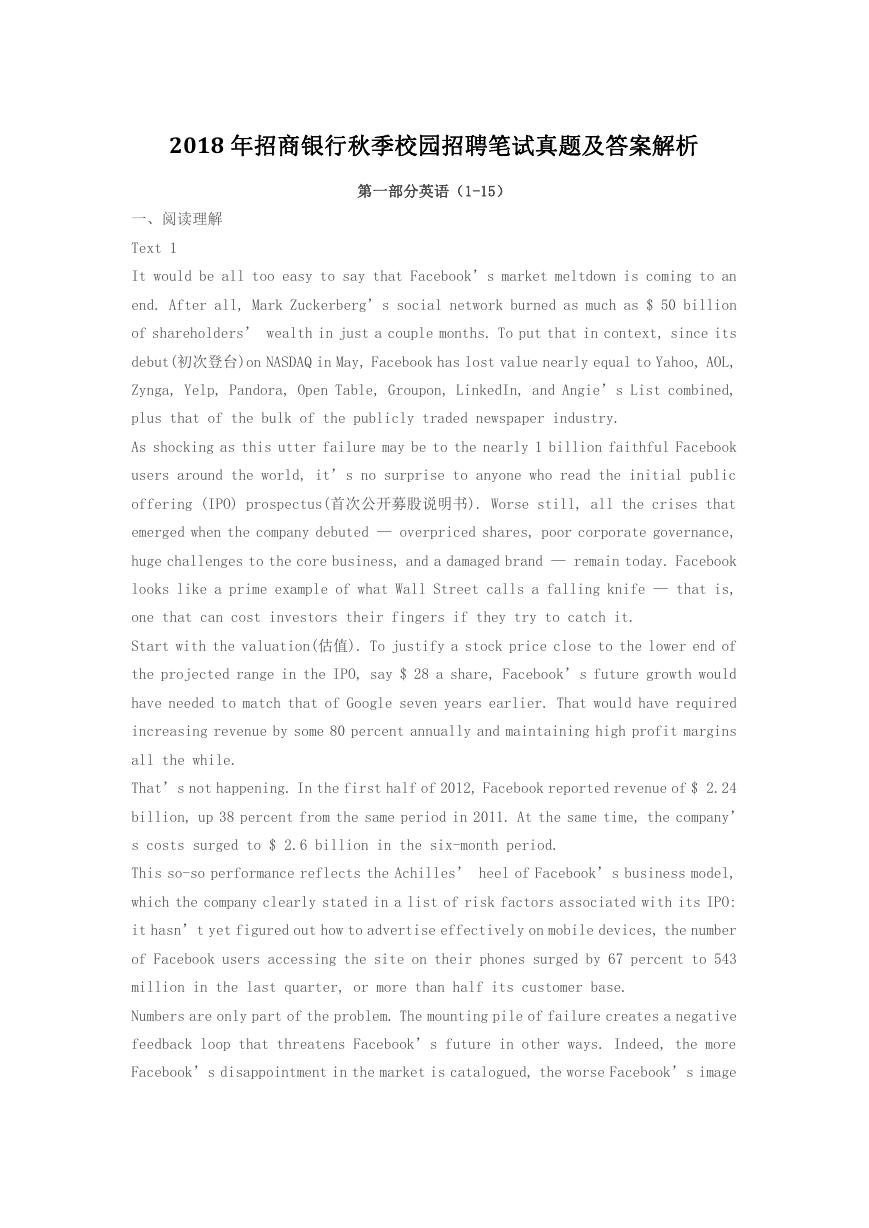
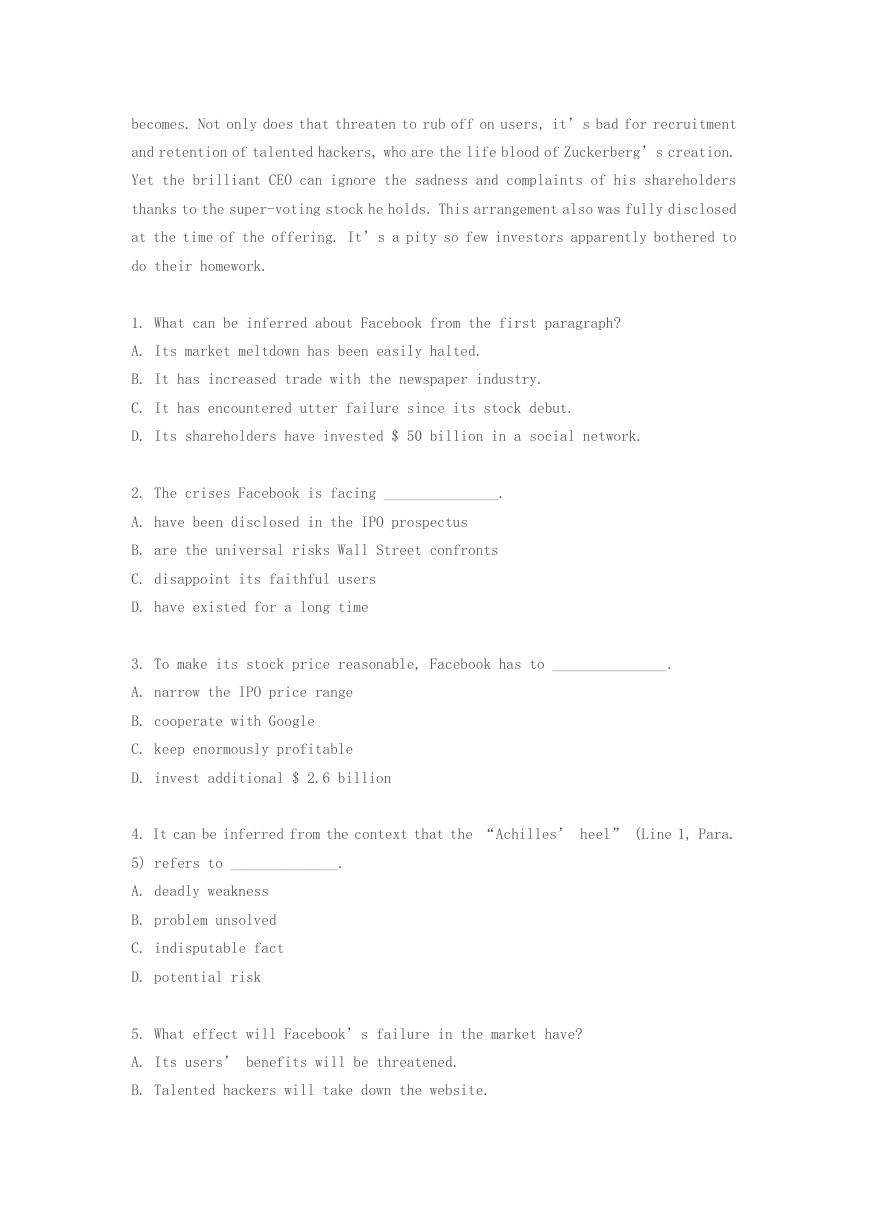
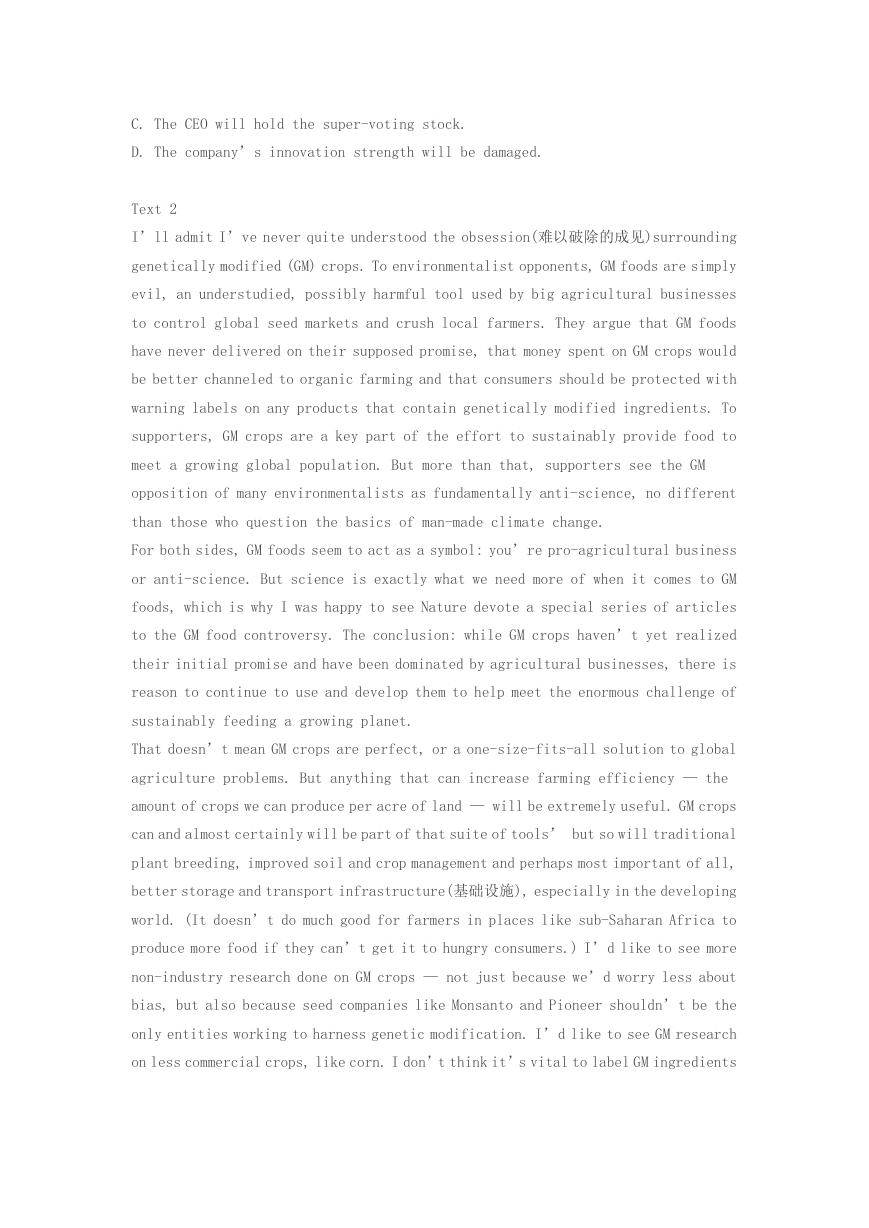
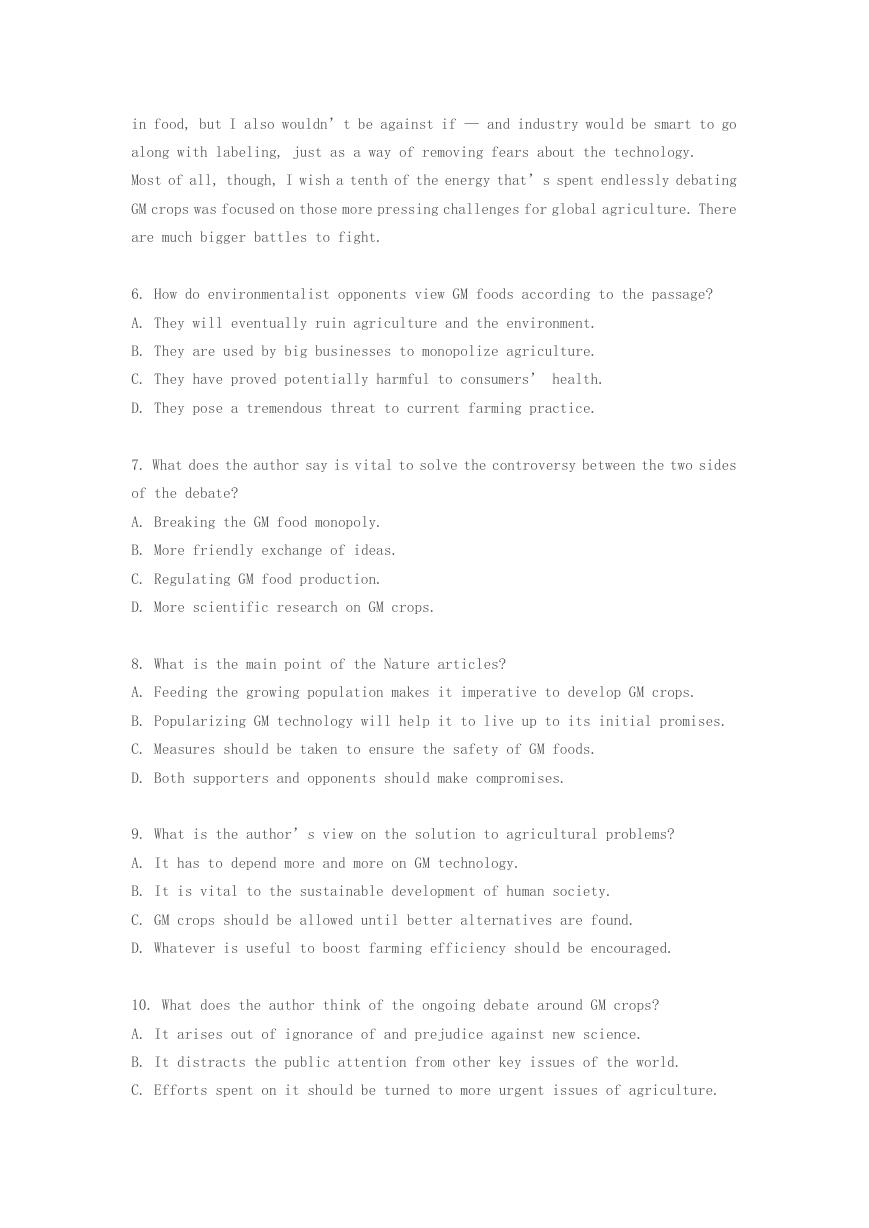
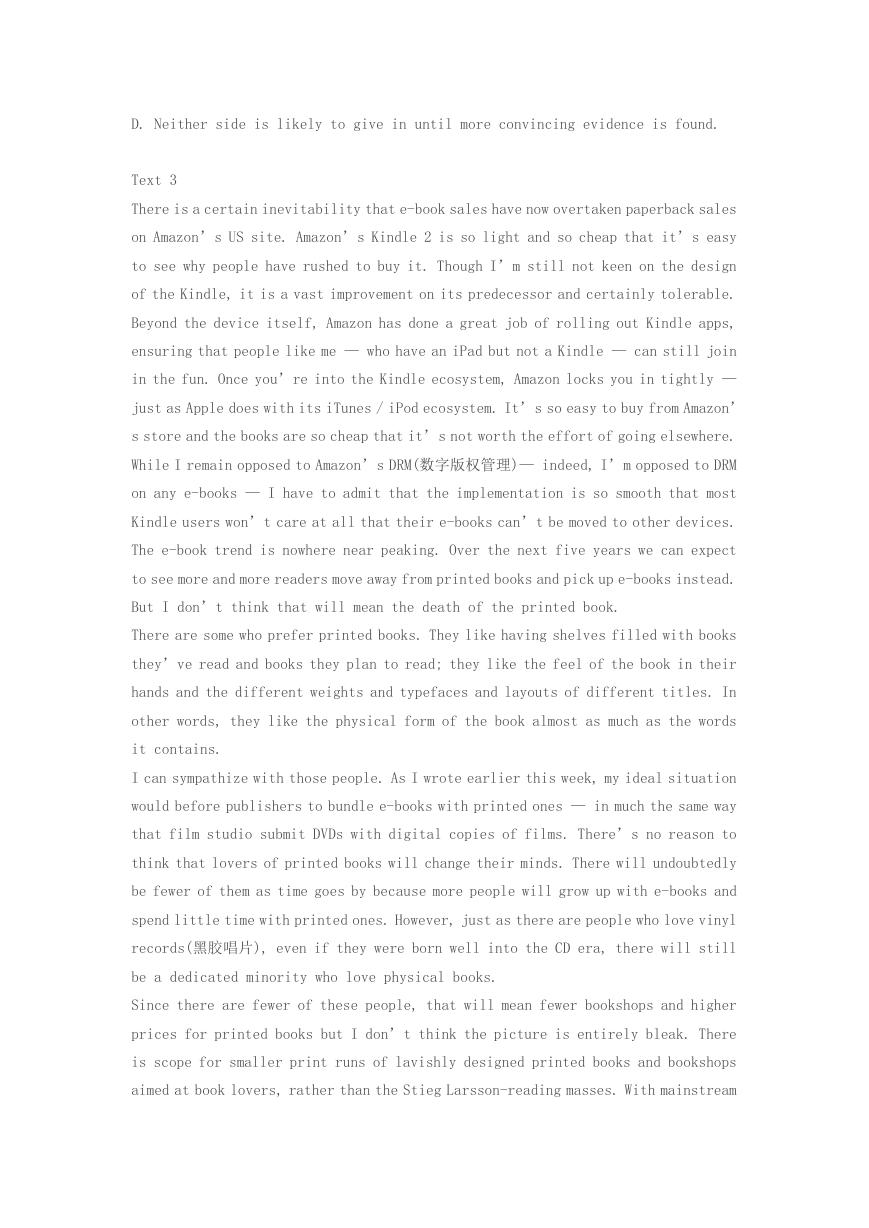











 2023年江西萍乡中考道德与法治真题及答案.doc
2023年江西萍乡中考道德与法治真题及答案.doc 2012年重庆南川中考生物真题及答案.doc
2012年重庆南川中考生物真题及答案.doc 2013年江西师范大学地理学综合及文艺理论基础考研真题.doc
2013年江西师范大学地理学综合及文艺理论基础考研真题.doc 2020年四川甘孜小升初语文真题及答案I卷.doc
2020年四川甘孜小升初语文真题及答案I卷.doc 2020年注册岩土工程师专业基础考试真题及答案.doc
2020年注册岩土工程师专业基础考试真题及答案.doc 2023-2024学年福建省厦门市九年级上学期数学月考试题及答案.doc
2023-2024学年福建省厦门市九年级上学期数学月考试题及答案.doc 2021-2022学年辽宁省沈阳市大东区九年级上学期语文期末试题及答案.doc
2021-2022学年辽宁省沈阳市大东区九年级上学期语文期末试题及答案.doc 2022-2023学年北京东城区初三第一学期物理期末试卷及答案.doc
2022-2023学年北京东城区初三第一学期物理期末试卷及答案.doc 2018上半年江西教师资格初中地理学科知识与教学能力真题及答案.doc
2018上半年江西教师资格初中地理学科知识与教学能力真题及答案.doc 2012年河北国家公务员申论考试真题及答案-省级.doc
2012年河北国家公务员申论考试真题及答案-省级.doc 2020-2021学年江苏省扬州市江都区邵樊片九年级上学期数学第一次质量检测试题及答案.doc
2020-2021学年江苏省扬州市江都区邵樊片九年级上学期数学第一次质量检测试题及答案.doc 2022下半年黑龙江教师资格证中学综合素质真题及答案.doc
2022下半年黑龙江教师资格证中学综合素质真题及答案.doc